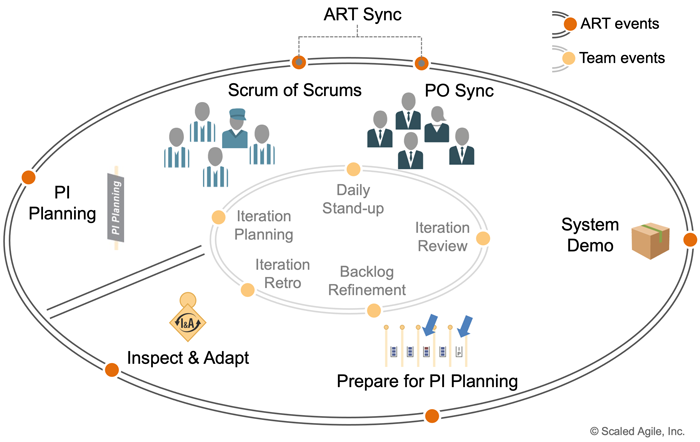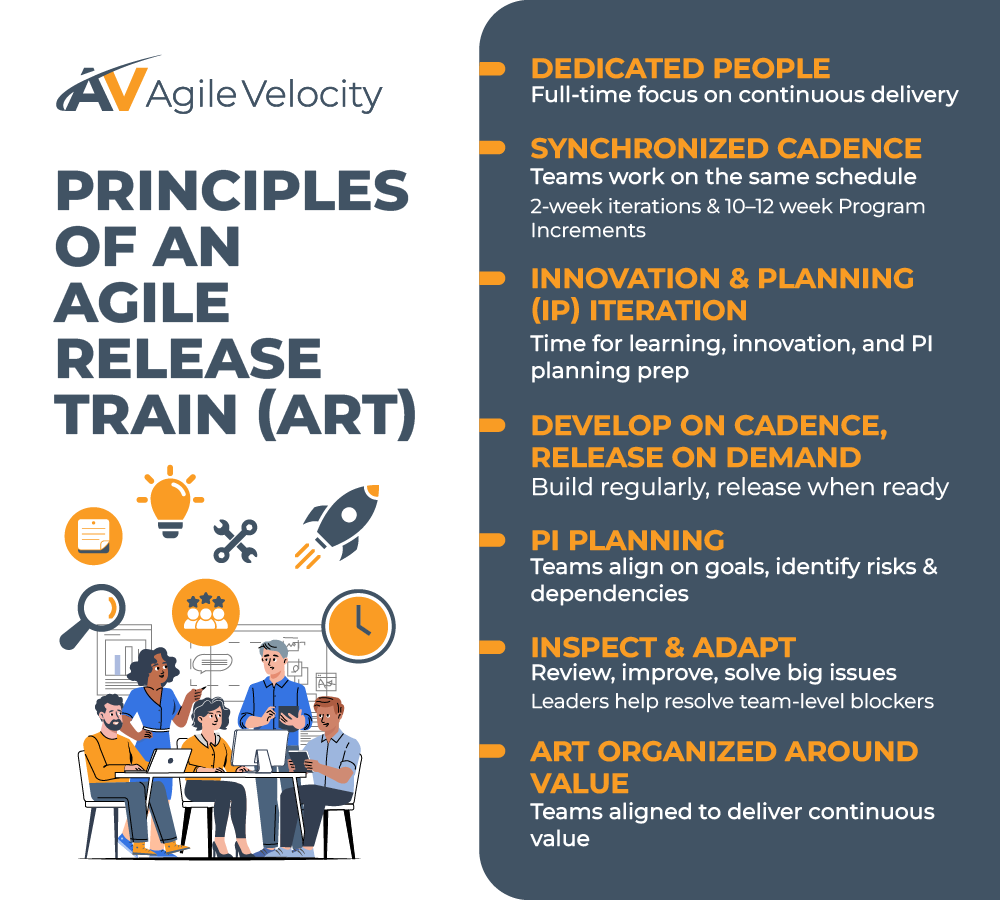Key Takeaways:
- Agile Release Train (ART) Defined: An Agile Release Train (ART) is a long-lived team of Agile teams (typically 50–125 people) that plans, develops, and delivers solutions together in a synchronized, iterative cadence as part of the SAFe® framework.
- Purpose of ARTs: ARTs are designed to align multiple teams around a common mission, improve collaboration, accelerate delivery, and resolve cross-team bottlenecks—making large-scale agile transformation more predictable and effective.
- Core Roles & Structure: Key roles within an ART include Release Train Engineer (RTE), Product Manager, System Architect, and Scrum Masters—each ensuring coordination, value flow, and alignment with organizational goals.
- Essential Events & Cadence: ARTs operate with fixed-length Program Increments (PIs), consisting of planning, iteration execution, system demos, and Inspect & Adapt sessions to drive continuous improvement and alignment.
- Benefits of ART Adoption: Organizations leveraging ARTs report better cross-team alignment, faster delivery of customer value, improved transparency, and enhanced ability to handle change across large, complex initiatives.
Is ART Right for You?: ARTs are ideal for organizations facing challenges with scaling agile practices, needing to align multiple teams, or aiming for more predictable delivery at scale—especially in environments where traditional team-level agile isn’t enough.
_________________________________________________________________________________________________
The Agile Release Train (ART) is a long-lived team of agile teams that, along with other stakeholders, incrementally develops and delivers value. It provides alignment and helps manage risk and dependencies by providing program-level cadence and synchronization. This Agile Release Train cheat sheet breaks down the purpose, principles, events, and members of the ART.
The Purpose of an Agile Release Train
The purpose of the Agile Release Train is to deliver value through a synchronized cadence. The ART is made up of cross-functional teams that enable a continuous flow of value delivery. It brings together all the people that are needed to plan, execute, and deliver valuable products and solutions.
The Principles of an Agile Release Train (ART)
To operate effectively, an ART follows a set of core principles outlined in the Scaled Agile Framework (SAFe®). These principles ensure alignment across teams, foster collaboration, and support predictable delivery of high-quality solutions.
Each principle plays a critical role in enabling the ART to plan, build, and release value efficiently while remaining flexible and responsive to change. Together, they form the foundation of how ARTs function within a Lean-Agile enterprise.
Below is a summary of the key principles that guide an ART’s structure and operation.
Dedicated people
- Most of the members of the ART are dedicated full-time to the ART, focusing on the continuous delivery of products and solutions.
Synchronized cadence
- All teams on the train have the same cadence of iterations, usually two weeks. It provides a synchronized start and stop time, allowing predictable delivery of smaller product/solution increments.
- There is an additional cadence of a Program Increment (PI) usually 10 – 12 weeks that enables the organization to make larger solution delivery more predictable.
PI Planning
- The expected outcome of this event is that all of the ART members have a shared understanding of the PI objectives, visibility on work needed to accomplish the objectives, and have surfaced risks and dependencies. The entire release train comes together during this process to enable a team of teams to commit to achieving the objectives with confidence and set reasonable expectations with stakeholders.
- Program risks are discussed openly and remediation efforts are public. Dependencies are not merely identified, they are discussed with all involved parties, and agreed-upon actions are captured and visualized on the program board.
Innovation and Planning (IP) iteration
- Occurs at the end of every PI to allow the train to innovate and learn. Teams are highly encouraged to dedicate time to continuing education and preparing for the next PI Planning event.
Inspect and Adapt
- Held at the end of the PI, teams showcase completed and integrated solutions and review Program Metrics along with a structured problem–solving workshop to reflect on improvement ideas.
- This is a great opportunity for leaders to engage, take ownership, and support resolution of organization-level impediments that teams are unable to fix on their own.
Develop on cadence, release on demand
- Teams on the ART develop on a synchronized cadence and release on demand. Decoupling deployment and release from the development cadence accelerates the delivery of a continuous flow of value to the market and customers. It also provides flexibility to the organization with how and when to release to customers.
ART organized around value
- Teams in an ART are organized around a common goal of providing continuous value to the customer. The teams are designed within the foundations of Team Topology. The four fundamental types are
- Stream Aligned Team – Stream-aligned teams focus on a single, impactful stream of work. It can be a single product or service, a single user journey, or a single user persona. The team is empowered to build and deliver customer or user value as quickly, safely, and independently as possible, without requiring hand-offs to other teams to perform parts of the work.
- Complicated Subsystem Team – A complicated-subsystem team is responsible for building and maintaining a part of the system that depends on specific skills and knowledge. Most team members must be specialists in a particular area of knowledge to understand and make changes to the subsystem.
- Platform Team – Platform teams enable stream-aligned teams to deliver work. While the stream-aligned team maintains full ownership of building, running, and fixing an application in production, the platform team provides internal services that the stream-aligned team can use.
- Enabling Team – The enabling team seeks to primarily increase the autonomy of stream-aligned teams by growing their capabilities with a focus on problems, rather than solutions.
Agile Release Train Roles and Responsibilities
A successful Agile Release Train (ART) relies on the coordinated effort of multiple roles, each contributing unique responsibilities and expertise to ensure consistent delivery of value. These roles work together as a unified team of teams, aligned around common goals, customer needs, and strategic business objectives.
While the ART operates on Lean-Agile principles, its effectiveness depends heavily on clear ownership, shared accountability, and seamless collaboration across various stakeholders. From customers and business owners to product teams and supporting roles, every member plays a vital part in enabling the ART to plan, build, test, and deliver high-quality solutions at scale.
Below is an overview of the key roles within an ART and their primary responsibilities.
- Customers/Users – Are the ultimate beneficiaries of the Product/Solution being developed by the agile teams.
- Business Owners – Are primarily responsible for business, technical governance, and the ROI of the product/solution being developed by the agile teams. These are the individuals that are accountable for the outcomes and weigh in on important tradeoff decisions.
- RTE – The Release Train Engineer is responsible for coordinating the PI events and ART Sync. The RTE is the Chief Scrum Master of the train, guiding the smooth operation of the ART by escalating impediments, visualizing cross-ART dependencies, and managing risks. Great RTEs also coach and provide advice to the train and its stakeholders, continuously improving the overall health and performance of the train.
- Agile Teams – Are a set of cross-functional groups of 5-11 individuals who define, build, test, and deliver an increment of value in a short time box. This includes the Scrum Master and Product Owner.
- Product Community – Helps define, guide, and support the building of customer-desired and sustainable products/solutions.
- Product Community – Helps define, guide, and support the building of customer-desired and sustainable products/solutions.
- System Team – Assists ART in delivering value by providing Infrastructure, enabling integration, and deployment.
ART Events Cadence and Synchronization

ART Events:
- SOS – Once a week (30 – 60 mins)
- POSync – Once a week (30 – 60 mins)
- System Demo – Atleast once every two weeks (30 – 60 mins)
- PI Planning Prep – Once a week (30 – 60 mins)
- Inspect and Adapt – Once every PI (3 – 4 hours)
- PI Planning – Once every 10 weeks (2 days)
Team Events:
- Daily Stand Up – Every Day (15 mins)
- Iteration Review – Once every two weeks (30 – 60 mins)
- Backlog Refinement – At least once every week (30 – 60 mins)
- Iteration Retro – Once every two weeks (30 – 60 mins)
- Iteration Planning – Once every two weeks (2 hours)
PI Planning Prep – Is a collaborative meeting to continuously prepare for the upcoming PI. The product community works closely with the Business, Architecture, and Delivery groups to prioritize and refine the next set of Features; Create any wireframes or mockups needed, and decompose Features into stories for the upcoming PI.
PI Planning – Is a two day planning session where the entire ART comes together to align development to business goals, commit to the team and program objectives for the PI, identify dependencies and risks, and come up with a plan to address those.
Inspect and Adapt – Is a workshop, held during the IP Sprint that includes a final System Demo, review of quantitative and qualitative metrics, and a Problem-Solving Workshop. This event is fundamental to the principle of relentless improvement of an ART.
ART Sync – Is a combination of PO Sync and Scrum of Scrums
- PO Sync – Promotes visibility into progress towards meeting PI objectives, reviews scope adjustments/tradeoffs, and assesses program risks.
- Scrum Of Scrums (SOS) – Facilitated by the RTE, SOS helps to coordinate dependencies across the ART and provides visibility into progress, impediments, or learnings across the ART.
How to Know If Your Organization Needs an Agile Release Train (ART): Quick Checklist
☑️ Multiple Agile Teams Struggling to Align: You have several agile teams working in parallel, but they regularly experience miscommunication, duplicated efforts, or conflicting priorities.
☑️ Complex Product or Solution Delivery: Your organization delivers products or solutions requiring coordination across multiple teams, functions, or departments.
☑️ Recurring Delays and Bottlenecks: Releases are often delayed due to unclear dependencies, lack of synchronization, or last-minute surprises.
☑️ Difficulty Scaling Agile: You’ve outgrown single-team agile (Scrum/Kanban) and need a structured approach to scaling agile practices.
☑️ Lack of Transparency and Predictability: Leadership and stakeholders complain about limited visibility into progress, risks, or outcomes across teams.
☑️ Desire for Consistent Delivery Cadence: You want to deliver value on a regular, reliable schedule of program increments (PIs).
☑️ Need for Unified Vision and Shared Goals: You struggle to keep all teams aligned to a common mission, roadmap, or value delivery objective.
If you check 3 or more boxes above, your organization might be ready to benefit from an Agile Release Train!
Tips for a Successful Agile Release Train (ART)
The success of an Agile Release Train depends on three key aspects:
1. Successful Launch
- Train the leaders, change agents, and team members
- Identify the first ART through a Value Stream Workshop
- Define the ART and its structure
- Leaders should have a clear message about why the ART is being formed and the shared goal(s) they intend the align the ART around
- Staff critical roles like RTE, System Architects, and Product Managers along with the typical Scrum roles like Scrum Master, Product Owners, and Development Team members
- Set the date of the first PI Planning and communicate it
- Execute the first PI with the goal of dedicated IP Sprint at the end of the PI
- Close the PI with an Inspect and Adapt workshop
2. Continued Support
- Any change is hard. Members that make up an ART and those that are required to support it might feel that the decision was imposed and will resist the change. Leadership should be crystal clear on the intent, transparent with communication, and supportive of the angst many might feel. Leaders at all levels should try to be available to guide members of the ART.
- Leaders should model behavior by moving away from directing the day-to-day work in support of the Product Owner and agile team, to defining the work, attending the Inspect and Adapt workshop, taking ownership of impediments, sharing progress on impediment removal, and broadly communicating team/ART successes.
3. Celebrate Wins
- Lack of celebration is one of the top reasons why teams are not motivated and is a wasted opportunity. Celebrating small wins helps build momentum, improve morale, and reward hardships.
Every organization is different and one size does not fit all. While SAFe implementation is fairly straightforward, being overly prescriptive isn’t recommended. Leaders should focus and invest in skilled people and empower teams for successful implementation.
If you’d like to learn more about ARTs or talk about getting the best results from your SAFe implementation, get in touch with Agile Velocity today.





